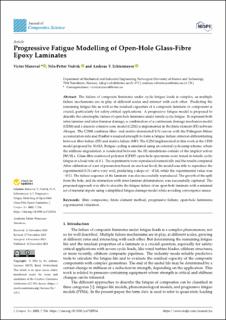| dc.contributor.author | Maneval, Victor | |
| dc.contributor.author | Vedvik, Nils-Petter | |
| dc.contributor.author | Echtermeyer, Andreas Thorsten | |
| dc.date.accessioned | 2024-01-17T13:39:15Z | |
| dc.date.available | 2024-01-17T13:39:15Z | |
| dc.date.created | 2023-12-13T14:40:53Z | |
| dc.date.issued | 2023 | |
| dc.identifier.issn | 2504-477X | |
| dc.identifier.uri | https://hdl.handle.net/11250/3112229 | |
| dc.description.abstract | The failure of composite laminates under cyclic fatigue loads is complex, as multiple failure mechanisms are in play at different scales and interact with each other. Predicting the remaining fatigue life as well as the residual capacities of a composite laminate or component is crucial, particularly for safety-critical applications. A progressive fatigue model is proposed to describe the catastrophic failure of open-hole laminates under tensile cyclic fatigue. To represent both intra-laminar and inter-laminar damage, a combination of a continuum damage mechanics model (CDM) and a discrete cohesive zone model (CZM) is implemented in the finite element (FE) software Abaqus. The CDM combines fibre- and matrix-dominated S-N curves with the Palmgren–Miner accumulation rule and Hashin’s residual strength to form a fatigue failure criterion differentiating between fibre failure (FF) and matrix failure (MF). The CZM implemented in this work is the CF20 model proposed by NASA. Fatigue cycling is simulated using an external cycle-jump scheme, where the stiffness degradation is conducted between the FE simulations outside of the implicit solver [90/0] s. Glass fibre reinforced polymer (GFRP) open-hole specimens were tested in tensile cyclic fatigue at a load ratio of 0.1. The experiments were reproduced numerically and the results compared. After calibration of a set of parameters based on one load level, the model was able to reproduce the experimental S-N curve very well, predicting a slope of −0.10, while the experimental value was −0.11. The failure sequence of the laminate was also successfully reproduced. The growth of the split from the hole, and its interaction with inter-laminar delamination, was successfully captured. The proposed approach was able to describe the fatigue failure of an open-hole laminate with a minimal set of material inputs using a simplified fatigue damage model while avoiding convergence issues. | en_US |
| dc.language.iso | eng | en_US |
| dc.publisher | MDPI | en_US |
| dc.rights | Navngivelse 4.0 Internasjonal | * |
| dc.rights.uri | http://creativecommons.org/licenses/by/4.0/deed.no | * |
| dc.title | Progressive Fatigue Modelling of Open-Hole Glass-Fibre Epoxy Laminates | en_US |
| dc.title.alternative | Progressive Fatigue Modelling of Open-Hole Glass-Fibre Epoxy Laminates | en_US |
| dc.type | Peer reviewed | en_US |
| dc.type | Journal article | en_US |
| dc.description.version | publishedVersion | en_US |
| dc.source.volume | 7 | en_US |
| dc.source.journal | Journal of Composites Science | en_US |
| dc.source.issue | 12 | en_US |
| dc.identifier.doi | 10.3390/jcs7120516 | |
| dc.identifier.cristin | 2213141 | |
| cristin.ispublished | true | |
| cristin.fulltext | original | |
| cristin.qualitycode | 1 | |

